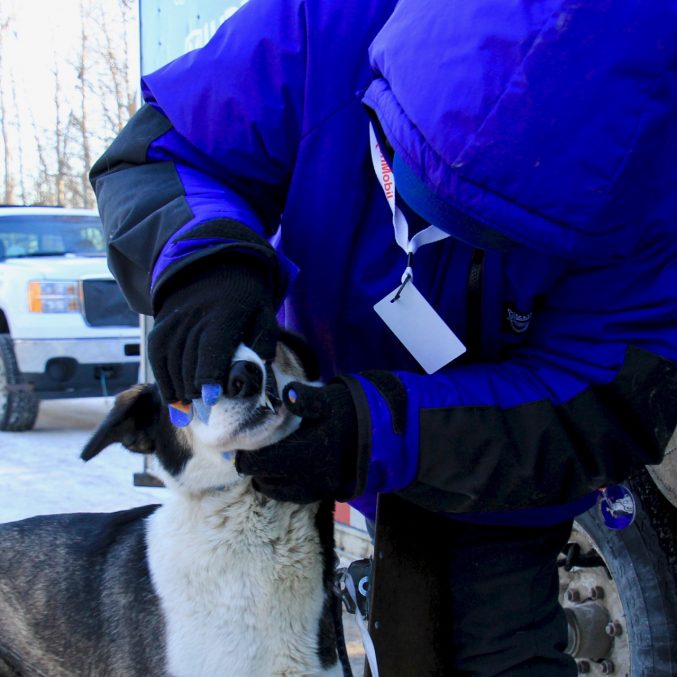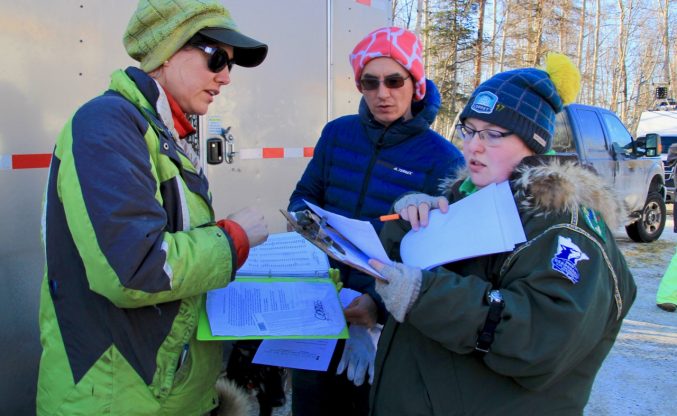
Checking Gums is Part of the Physical
If you ever have the chance to speak with any musher, or see them with their dogs, you will quickly learn how much the mushers love their dogs, know their dogs, care for their dogs, and will do anything to ensure that their dogs are happy and healthy. On a year-round basis, mushers conscientiously and attentively care for their dogs. Having had the opportunity to closely experience many facets of the Iditarod, one thing I’ve noticed that’s incredibly evident is the fact that the well-being of each dog is the most important thing and top priority for everyone involved with The Last Great Race®. The Iditarod Trail Committee has numerous measures and rules in place that aim to further make sure that the dogs are healthy. One of the measures is the mandatory pre-race veterinary screening. In the Idita-world, these screenings are referred to as vet checks.
During a vet check, veterinarians closely examine the dogs and assess a variety of things. The vets will evaluate each dog’s general appearance, body condition, mental activity (mentation), posture, hydration status, and vital signs, among other things. In addition to the pre-race vet check, every dog must have a microchip implanted, they must have blood testing, and they must have an ECG (electrocardiogram) performed in order to screen their heart rate and heart rhythm. Every dog must furthermore be up-to-date with his/her vaccinations, and they also need to be de-wormed within 10 days of the race.

Marcelle Fressineau’s Dogs Await Their Appointment for Vet Check.
Today, at the ITC Headquarters, mushers had the opportunity to bring their dogs to the vet check. According to rule 40 of the 2019 Iditarod Race rules, mushers had until 5:00 P.M. this evening, February 27, 2019, to submit their veterinarian paperwork. Mushers are permitted to have up to 24 dogs screened in preparation for the race; however, mushers are only allowed to select a maximum of 20 dogs to include on their Dog Microchip Identification Sheet–this document is part of veterinarian paperwork. Then, based on the submitted and approved paperwork, a musher may only select dogs to race in the Iditarod who are listed on their Dog Microchip Identification Sheet (as well as the other paperwork). This year, for the re-start, a musher is allowed to have a maximum of 14 dogs in the race. The minimum number of dogs to start the race is 12.
The teachers attending this year’s Iditarod Winter Conference for Educators had the opportunity to see today’s vet check at the ITC headquarters. Many mushers were spotted including Martin Buser, Matt Hall, Anna and Kristy Berington, Jessie Royer, Ryan Redington, Kristin Bacon, Blair Braverman, Marcelle Fressineau, Sebastien Dos Santos Borges, and Jason Campeau. Although they were very busy, the mushers would kindly take time to answer questions, take photos, and allow the teachers to say hello to their dogs.

Ryan Redington Goes Over Paperwork With Vets
Another familiar person who was seen during the vet checks was Dr. Stuart Nelson, Chief Veterinarian of the Iditarod. Stu has been the chief veterinarian since 1995 and he was a volunteer trail vet during the race for nine years prior to that. Dr. Nelson is certainly not the only vet to work with the dogs and the mushers. In fact, every year, up to fifty volunteer veterinarians travel from all over the world to help out with the Iditarod.

Chief Veterinarian, Dr. Stu Nelson
Now that the vet checks are completed, the excitement level is certainly increasing because that means the start of the race is drawing nearer. If you want to learn more about the many measures that are taken in order to make sure that the dogs are healthy, safe, and monitored, check out this resource. Additionally, you can read more about dog care in the 2019 Iditarod Race Rules. Consider having your students conduct research to learn more about the anatomy and physiology of sled dogs. Have students compare and contrast sled dogs to humans: heart rate, heart rhythm, average/normal body temperature, average weight, amount of bones, number of teeth, colors of gums, average number of breaths taken per a minute, etc. Students will enjoy learning more about the dogs and they’ll be able to apply that knowledge to their understanding of the race.


